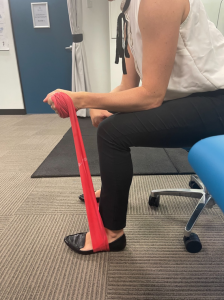What is De Quervain’s Tenosynovitis?
 De Quervain’s Tenosynovitis is inflammation of the tendons located on the side of the wrist towards the base of the thumb.
De Quervain’s Tenosynovitis is inflammation of the tendons located on the side of the wrist towards the base of the thumb.
The two tendons involved are the tendons of extensor pollicis brevis (EPB) and abductor pollicis longus (APL) muscles which are located at the base of the thumb.
These two tendons are required to travel under a fibrous tunnel called the extensor retinaculum. The tunnel is lined with a slippery coating called the tenosynovium. Overuse of the thumb can cause inflammation of the tendons and tenosynovium which is called tenosynovitis.
Symptoms of De Quervain’s Tenosynovitis:
Symptoms of De Quervains include soreness on the thumb side of the wrist, which may radiate up the forearm.
Pain may increase with movements of the thumb and grasping movements of the hand. Thickening and swelling of the tendons and the surrounding areas may also be present.
Causes of De Quervain’s:
De Quervains is caused by thickening of the tendons which restricts the movement of the EPB and APL tendons within the tunnel leading to inflammation and irritation.
De Quervains is thought to be a chronic overuse injury and is associated with repetitive wrist motions. It can also be caused by complications resulting from inflammation of scar tissue caused by other conditions and occasionally can have no direct cause or mechanism of injury.
If left untreated, the inflammation can cause progressive narrowing of the space between the tendons, tendon sheath and extensor retinaculum resulting in limited thumb motion.
Diagnosis of De Quervain’s:
De Quervains is diagnosed by conducting a thorough patient history and performing specific physical tests.
The therapist will confirm the presence of common signs and symptoms such as pain over the thumb and/or wrist which may radiate up the arm during grasping and movements of extension of the thumb and also pain which is aggravated by repetitive movements of the hand. They may also be swelling of the anatomical snuff box and tenderness at the radial styloid as well as decrease ROM and strength of the first digit.
Symptoms should also be reproducible with the Finkelstein’s test which applies force through the tendons. To perform the Finkelstein’s test you grasp your thumb with your fingers making a fist with the thumb inside and bend your wrist away from your thumb in a side to side motion. If you feel pain over the thumb tendons, your problem is probably De Quervain’s tenosynovitis.
Treatment of De Quervain’s:
Although De Quervains can resolve on its own it can become a chronic condition. For those with persistent or recurrent symptoms a treatment program involving splinting, manual therapy and progressing strengthening on thumb, fingers and wrist is recommended.
Splinting reduces movement thus allowing time for any inflammation in the tendons to settle. Depending on the severity of symptoms the splint can be worn at night time only or in severe cases it is required to be worn 24 hrs for up to six weeks and is only to be taken off for strengthening exercises.
Manual therapy techniques include mobilisations to the wrist and carpal bones as well as soft tissue release the muscles of the forearm.
The final phase of the rehab program involves strengthening exercises, which need to be carefully selected to ensure they don’t irritate the tendons.
An example of a suitable exercise is the eccentric hammer curl with a resistance band.
If you are experiencing pain at the side of your hand book in for a consultation with one of our therapists and we will make sure to look after you!


Post by: Physiotherapist Sarah Loveband





